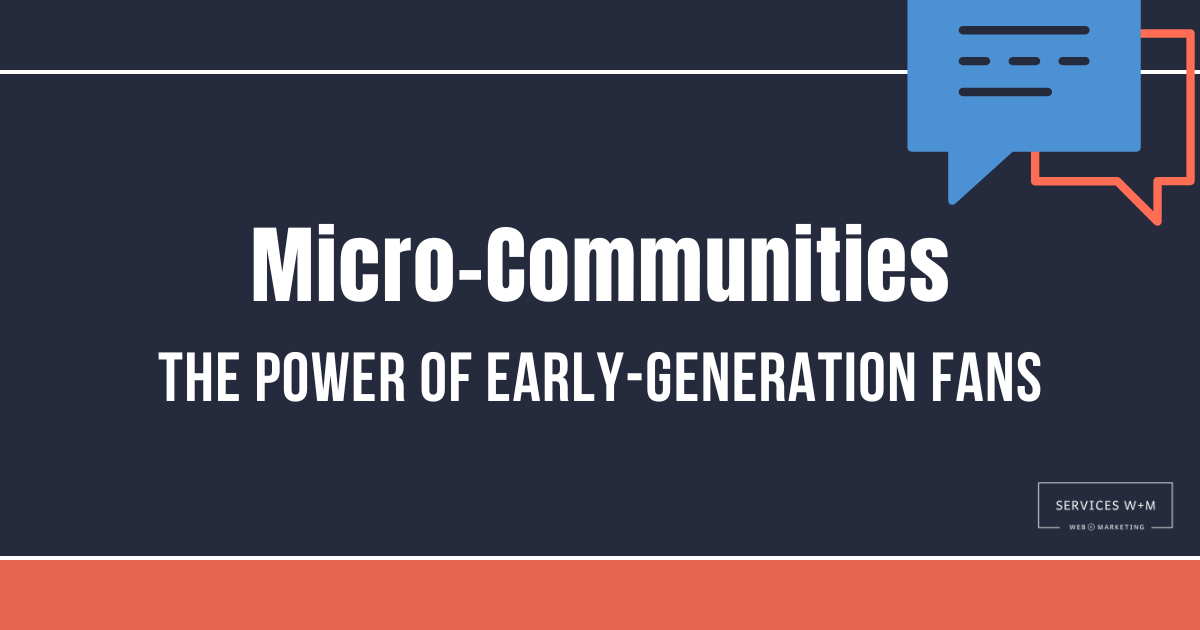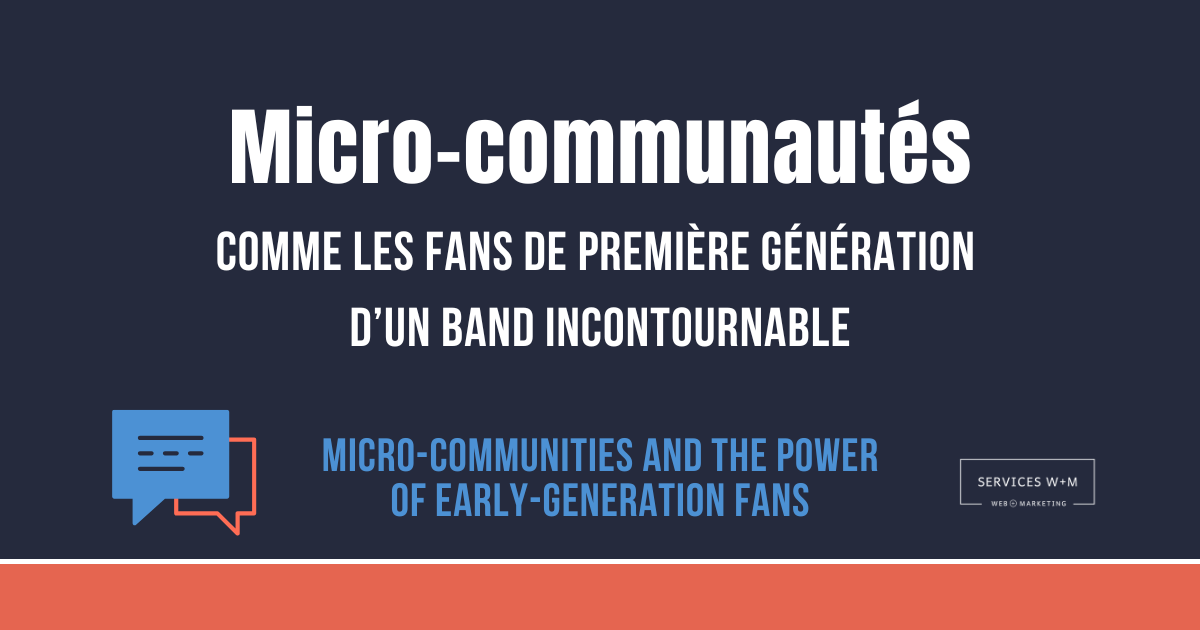Micro-Communities: The Power of Early-Generation Fans
Explore why micro-communities, the early-generation fans of brands, are reshaping modern marketing. A closer, more human, high-engagement digital strategy.
Hello,
There’s something magical about the early days of a band. Before the big shows, before the tours, before the corporate merch.
I’m talking about the first phase. When only a few lucky ones have witnessed: the tiny venues, the amps pushed too far, the singer whose microphone stand almost hits your knee because the stage is barely a stage at all.
That’s where early-generation fans are born. The ones who were there before everything became a machine. The ones who saw the band up close, truly up close, no screens, no filters, no distance. The ones who can proudly say: “I was there when they were still playing in front of forty people.”
Those people aren’t just fans. They are a micro-community.
A small group that recognizes itself instantly — sharing a vibe, values, lived moments, and a loyalty that almost nothing can break. They follow the band for years, long after the arena crowd has misplaced its ticket.
Today, marketing is trying to recreate what those tiny venues have always known how to produce: proximity.
Let’s explore it together.
Enjoy your reading, Marketers.
MusicScore : Jeff, the writer, was listening to this while working on this article: I Feel for You - Chaka Khan.
Why Micro-Communities Are Emerging in 2025
The public web has become a venue that’s too big, too bright, and far too loud.
We receive everything, all the time, without ever really listening. From pop-ups to alerts, platforms multiply formats, creators multiply content, brands multiply messages… but attention doesn’t follow.
So people move elsewhere. They leave the big halls for smaller, more intimate spaces — little digital bubbles where words regain their value and where, finally, you know who you’re talking to and why.
Micro-communities emerge quietly, without announcements or noise. They grow the same way early fans gathered around a band: one recommendation whispered, one invitation shared, one moment that makes you think “these people get me.”
Trust rebuilds itself naturally because the space feels more like a conversation than a campaign. In a small group, an opinion becomes a real opinion. A comment becomes an exchange. Even silence means something.
Where the public scroll flies by without stopping, in a micro-community, people stay. They notice. They share the good news.
A New Kind of Digital Intimacy
Businesses that explore these smaller communities rediscover something lost: time. In a small space, the relationship doesn’t need to be spectacular. It can be slow, simple, imperfect — but real.
A newsletter sent to 200 genuinely interested readers can build more loyalty than a social feed that reaches thousands. A small group of local entrepreneurs can generate more ideas than a public page followed by an entire region. A specialized circle can turn a reader into a collaborator, a client into an ambassador, a brand into a reference point.
In these micro-spaces, marketing loses its anonymity and recovers its voice. Not a “brand voice,” but a human one that knows the names, the needs, the reactions, the life moments. A voice that listens before it responds.
It’s the difference between performing in front of ten thousand people and playing an acoustic set for twenty. Both exist, but the impact isn’t the same.
The Kind of Value That Feels Good
Micro-communities aren’t looking for perfection. What they want is consistency. They don’t ask for more content, they ask for content that matters.
For small businesses, this shift feels almost liberating. You can aim narrower, but hit right. Invest less in visibility, but more in relationships. Find more value in a group of one hundred people than in a crowd of ten thousand.
This approach requires patience, curiosity, and sometimes a bit of humility. Like any sincere human relationship.
Where Micro-Communities Form
Despite what we might think, micro-communities don’t belong to a single platform.
They appear wherever there is:
a sense of belonging,
a space for exchange,
a shared value.
Some take shape in newsletters we open the way we open a letter from a friend. Some grow inside private Facebook groups, still one of Québec’s strongest communal gathering places. Creators gravitate toward private Discord servers, digital jam rooms where everyone drops ideas. More technical businesses gather clients in private Slack workspaces — half meeting room, half warm lounge.
Even podcasts have become a kind of modern small venue. Listening to someone week after week, their voice, their rhythm, their hesitations, creates a surprisingly deep connection. A podcast isn’t a micro-community on its own, but it often becomes the spark, the nucleus, the first encounter.
Wherever a group shares references, codes, and a little bit of intimacy : a micro-community can emerge.
Micro-Communities That Are Easy to Build
People often imagine that you need complex structures to build a community. In reality, some of the strongest ones start in incredibly simple places.
A small Messenger group where a handful of people exchange ideas.
A private, more personal newsletter written late at night.
An Instagram Broadcast channel that becomes a morning ritual between a creator and their closest followers.
A small Facebook group dedicated to a neighbourhood, a product, or a niche passion.
A closed Discord server that feels like a creative studio.
A private Slack space that keeps your best clients close, day after day.
Even a basic membership — one Zoom meeting per month, one exclusive piece of content — can create a small digital refuge.
These spaces aren’t huge. They aren’t perfect. They aren’t noisy. But they’re alive and that’s enough for a micro-community to exist.
Conclusion
Will 2026 be the year communities make a comeback? Maybe.
One thing is certain: mass marketing isn’t gone, just like arena tours aren’t going anywhere. But digital behaviour is pulling us toward something else: a constellation of smaller spaces where conversations last longer, reactions are more sincere, and relationships hold.
Québec businesses that understood this early have gained a valuable advantage: they’re speaking to people who genuinely listen.
And maybe that’s the new luxury of the web! Being followed not because someone has to, but because they want to. Being discovered in a tiny venue… and followed long after the lights change.
Thank you for reading,
See you on the Blog.
Jeff Maheux, W+M
Cr images: Production Services W+M.
Websites - creation, management and design
I edit the content of existing sites via CMS in addition to creating sites with WordPress and Squarespace. I have been producing website content as a webmaster since 1998.
I help companies get their first website up and I improve the performance of existing sites.
Yes, I’m Mr. Analytics and my reaction time to new digital marketing is daily, which allows my clients to have optional and trend-cutting tools.
Follow the content of the marketing blog and participate in the articles by commenting, with respect, on the content of the site, intended for Quebec companies operating in the digital market.
Jeff, A W+M Agent.








Artificial intelligence is quietly becoming part of our everyday habits — often without us noticing. From marketing tools to lunch breaks, it slips into our simplest gestures. Maybe the real revolution isn’t its power, but the fact that it’s becoming routine.